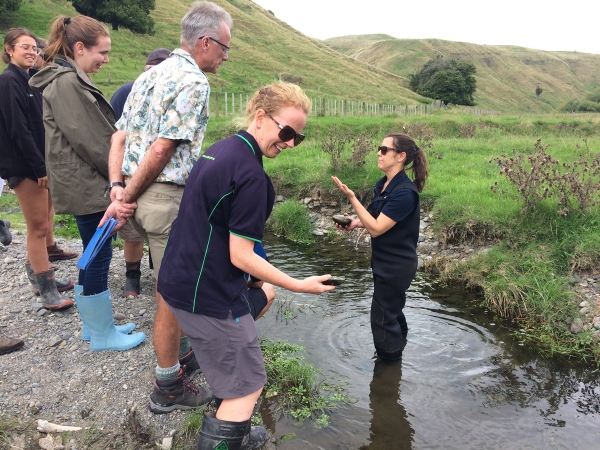NIWA has updated training materials and restarted a course that explains the use of a riparian planning tool to achieve a range of water quality and environmental outcomes.
This tool was originally developed by former chief scientist and Hawke’s Bay resident, the late Dr John Quinn. He developed the Riparian Management Classification (RMC) in the late 1990s to help design and manage riparian planting projects.
NIWA Land and Water Scientist Lucy McKergow originally presented the Targeted Riparian Management Course with Dr Quinn. She has now restarted the programme and is leading it with assistance from NIWA Freshwater Ecologist Elizabeth Graham, both are based in Hamilton.
“John developed the RMC as a thought-experiment to help landowners, council land management officers and farm advisors assess how riparian functions vary across catchments,” McKergow said.
The concept is to provide realistic, science-based expectations of riparian buffer performance for 12 different functions, including provision of fish habitat and shading, and other water quality outcomes.
“We understand regional council staff are being approached by rural landowners asking how to tell if their stream is healthy.
“This course gives them the tools to increase their knowledge and confidence, to explain and educate landowners about their streams’ ecosystems.”
Twelve Hawke’s Bay Regional Council staff attended the first Targeted Riparian Management Course held since 2015 in late February 2022.
Attendees had a background in physical geography and were looking to increase their knowledge around stream ecosystems.
Xan Harding is Senior Catchment Advisor (Policy Implementation) for the Hawke’s Bay Regional Council.
He said the Riparian Management Classification system at first appeared complex.
But staff completed the course much more informed and confident to use the system for understanding, assessing and managing the broad range of elements that comprise stream health.
The course provided guidance which will help staff deliver good advice to landowners.
“For example, we learnt that to achieve 70 per cent shading of a waterway, the rule of thumb is that the maximum height of your trees needs to be the same as the width of a stream.”
This is recommended to limit growth of nuisance weed and algae, and to assist with water temperature regulation if long lengths of riparian corridor can be shaded.
“We also learnt that carbon input from trees which have fallen into streams is essential to the health of waterways. Woody material provides habitat and leaf litter is a food resource for aquatic life.”
Harding said it was a bonus to have regional council staff complete practical work alongside the NIWA researchers.
It was a rare opportunity to benefit from their experience, coupled with powerful course materials delivered effectively.
Lucy McKergow said the regional council staff will be able to put the course knowledge into action.
“We have been training the trainers, to provide people with the correct advice to share with rural landowners, iwi and community groups, river care or land care groups.”
Since the initial course was run in February, three more have been run for the Department of Conservation’s Ngaa Awa Programme in Hokitika, involving DoC staff, as well as teams from iwi and hapu, nurseries, regional councils and environmental restoration managers.
Useful links:


